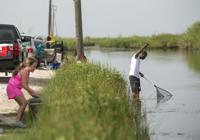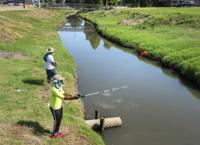If there was a particularly bad time for Louisiana to stop testing waterways for toxic fish, it would be now.
Fishing is booming amid the coronavirus pandemic, with stay-at-home orders and social distancing guidelines inspiring Louisianans to take up rods and reels in numbers not seen in nearly a decade.
“People are off work and getting a little stir crazy, so we’ve had quite a surge in fishing licenses,” said Bryan McClinton, manager of the state Department of Wildlife and Fisheries licensing program. Between March and June, license sales were about 50% higher than the same period last year.
But the state Department of Environmental Quality’s fish-testing program, which helps advise all those freshly licensed anglers where fish are safe to catch and eat, will soon run out of money. The program no longer gets direct financial support from the state and has had to rely on a one-time allotment of funding from a legal settlement to limp along at diminished capacity over the past four years.

Louisiana Department of Environmental Quality environmental scientists Corey Schwartzenburg and Carrick Boffy collects fish for mercury testing in the Atchafalaya River basin June 1, 2016.
“It’ll still go on a little while, but the money is running out,” said Al Hindrichs, manager of the testing program. “We have a couple months at least.”
Officials say the program is vital for protecting human health but the state’s new $35 billion budget has no money to keep it afloat, and no future funding sources, which could include state tax dollars, grants or donations, have been identified by DEQ.
The program supports fish tissue sampling at dozens of sites around the state each year. When high levels of contamination are detected, fish consumption advisories are issued by state health officials. Most of the 58 advisories are linked to mercury, a heavy metal that can stunt brain development and inflict long-term damage on the kidneys and heart. It’s especially harmful for children and developing fetuses. Pregnant women have long been warned against eating too much deepwater fish, such as tuna, amberjack and mackerel – all of which are under advisories on the Louisiana coast.
The testing program found plenty to be concerned about in freshwater, including hundreds of miles of rivers and bayous and thousands of acres of lakes. Elevated levels of mercury were detected in Tangipahoa River and Tchefuncte River catfish, Tickfaw River crappie, and several fish species in the Amite River Basin.
“Mercury is in so many places and it’s not going away,” Hindrichs said. “When you find it, it’s not something you can just shut off.”
DEQ spent much of the last four years re-testing sites that were assessed several years ago. In recent months, DEQ expanded to untested waterways and would likely continue gathering new data if funding was available. DEQ officials say the program could be stretched another year, but that would likely mean a less aggressive approach, with a trimmed travel budget and more emphasis on sites with easy access.
Before DEQ cut funding to the program, the testing team averaged 100 site visits per year. Since 2016, when a legal settlement revived testing, the annual average has dropped to just 41.

A long line of parked cars where people were fishing and crabbing near Bayou Lacombe on Thursday, July 2, 2020.
Barry Kohl, a Tulane University environmental scientist and longtime proponent of the program, said DEQ should start hunting for money now to not just maintain the program but expand it.
“If they don’t keep it going, it means they’re not doing their damn job,” he said. “It’s a significant public health issue and they need to take it seriously.”
There was a time when Louisiana was a national leader in tackling the mercury problem. In 2004, the state launched an ambitious mercury reduction initiative that ramped up a program that not only tested fish but soil and water. It also funded a program to educate the public about the hazards of mercury contamination.
“What we were doing was actually unheard of in Louisiana,” said Chris Piehler, a retired DEQ scientist who oversaw the mercury program. “We had one of the most comprehensive programs in the country at the time, and we went to great lengths to get good data.”

A public warning posted on to a cypress tree gives a warning about eating fish from Bayou Liberty in St. Tammany Parish on Thursday, July 2, 2020.
Coal power plants have been a main global source of mercury in the environment. Particles released by burning coal enter the atmosphere and fall into waterways, where they’re taken up by fish and other aquatic life. In Louisiana, other causes of mercury pollution have included chemical plants, wood treatment facilities and pressure meters in pipelines.
The testing program revealed certain types of waterways had normal levels of mercury but the fish had unusually high mercury contamination.
“It was the acidic dark water; the slow-moving swampy areas,” Piehler said. Bacteria that thrive in these areas chemically change mercury so it can more easily enter the food chain.
“And Louisiana is full of these kinds of places,” Piehler said.

Carrick Boffy, a Louisiana Department of Environmental Quality environmental scientist, scoops up fish in the Atchafalaya River basin June 1, 2016. Samples of the fish flesh was sent to laboratory to look for mercury contamination.
The fish testing program cost about $500,000 per year and led to an average of three new mercury advisories per year.
That all ended in 2008, when DEQ gutted the program amid a push by Gov. Bobby Jindal to force cuts across various state agencies. For eight years, there was no fish tissue sampling, except in the aftermath of a chemical or oil spill.
State law requires the program to draw its funding from tax dollars, grants or donations. DEQ has been hesitant to ask for more funding from the Legislature or push for a rule change that would allow the use of money from fees or fines.
In 2015, environmental groups put pressure on DEQ to revive the program. “We had to embarrass the hell out of them,” Kohl said. It worked, apparently.
“Our butt was hanging out and we had to cover it up,” Piehler said.

Quincy Muse, foreground, and his cousin Jimmie Armstrong fish Corporation Canal in Baton Rouge on May 27, 2020. Muse had tried the canal previously, and come up with brim, catfish and sac-a-lait.
Within weeks of a contentious meeting with Kohl and other testing advocates, DEQ restarted a smaller-scale version of the program with $1.5 million that had been paid by power company NRG Louisiana Generating in lieu of a fine.
Hindrichs said recent testing shows no significant changes in mercury concentrations. Over the past four years, DEQ has added only one new advisory: a warning about eating bass and bowfin in a 7-mile stretch of Two O’Clock Bayou in St. Landry Parish.
DEQ spokesman Greg Landry noted that many of the state’s highest mercury emitters have shut down and coal is powering fewer plants.

A catfish caught from the Mississippi River near Kenner in 2009.
“Atmospheric mercury is less than it was, and most of the mercury we were getting was from aerial deposition,” he said.
That doesn’t mean testing should cease, Kohl said.
“If you don’t test, you don’t find problems,” he said. “Some people like that. Ignorance is bliss.”
Fisheries managers say advising the public about contaminated fish is especially important now as more people look for free or inexpensive food after losing jobs or income due to the pandemic.

Bobby Robertson and Michael Collins fish and crab from a tiny boat near Bayou Lacombe in St. Tammany Parish on Thursday, July 2, 2020. (Photo by Chris Granger | The Times-Picayune | The New Orleans Advocate)
Many of the people who bought the 156,000 licenses sold during the state stay-at-home order are casual anglers who haven’t fished in years or people wanting to “fill up their freezers,” said McClinton, the Fish and Wildlife licensing manager.
“A lot of people are looking to supplement their grocery budget these days,” McClinton said.
They’re more likely to cast into whatever drainage ditch or bayou is near their home and eat almost anything they catch. What sport fishermen consider a “trash fish,” like bowfin, are a staple part of the diet in some poor, rural communities. Bowfin, which often dwell in shallow, stagnant ponds and bayous, is listed on dozens of advisories as a high risk for young children and women of childbearing age.
“In the cities, people are standing in lines because they don’t have money to buy food,” Kohl said. “But in the country, people know if you catch one big catfish or bowfin, you can feed a family. Is it going to give the kids mercury poisoning? We don’t know unless we do the testing and we communicate (the risks) to the public.”
"fish" - Google News
July 04, 2020 at 02:30AM
https://ift.tt/2C1NnBd
Are Louisiana fish safe to eat? State mercury testing program in peril as fishing surges during pandemic - NOLA.com
"fish" - Google News
https://ift.tt/35JkYuc
https://ift.tt/3feFffJ
Bagikan Berita Ini
















0 Response to "Are Louisiana fish safe to eat? State mercury testing program in peril as fishing surges during pandemic - NOLA.com"
Post a Comment